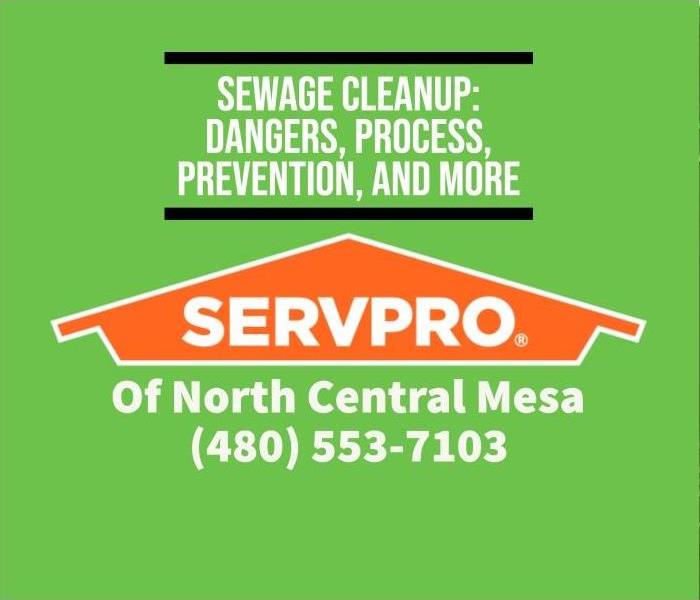Sewage Cleanup: Dangers, Process, Prevention, and More
3/24/2023 (Permalink)
A sewage backup can be a nightmare for any property owner in Mesa, AZ. Not only is it unpleasant, but it also poses significant health risks and can cause extensive damage. SERVPRO of North Central Mesa is here to help you understand the dangers of sewage backup, the cleanup process, and how to prevent such incidents. We will also address additional questions related to sewage cleanup to provide a comprehensive overview of the topic.
What Are the Dangers of Sewage Backup?
Sewage backup poses several dangers to both your property and health:
- Contamination: Sewage water contains bacteria, viruses, and other harmful pathogens that can contaminate your property and pose a serious health risk to occupants.
- Mold growth: The presence of moisture and organic materials in sewage can create ideal conditions for mold growth, which can lead to structural damage and health issues.
- Structural damage: Sewage water can seep into building materials, causing them to warp, rot, or weaken over time.
- Electrical hazards: Sewage water can damage electrical systems, creating a risk of electrocution or electrical fires.
- Odors: The foul odors associated with sewage backup can permeate your property and be difficult to eliminate without professional help.
How Is Sewage Cleaned Up?
The sewage cleanup process involves several steps to ensure that your property is thoroughly sanitized, decontaminated, and restored:
- Assessment: The affected area is inspected to determine the extent of the damage, the type of sewage contamination (black, gray, or clean water), and the necessary precautions and equipment.
- Removal: All standing water and sewage are removed using professional equipment such as pumps and wet vacuums.
- Contaminated material disposal: Porous materials that have absorbed sewage water, such as carpets, drywall, and insulation, are removed and safely disposed of.
- Cleaning and sanitization: The affected area is cleaned and sanitized using specialized cleaning agents and techniques to eliminate bacteria, viruses, and other pathogens.
- Drying: Dehumidifiers and air movers are used to remove excess moisture and expedite the drying process.
- Odor removal: Odor removal techniques, such as air scrubbers and ozone generators, are employed to eliminate lingering odors.
- Restoration: The final step involves repairing or replacing damaged materials and restoring your property to its preloss condition.
How Can I Prevent Sewage Backup?
To reduce the risk of sewage backup in your property, follow these tips:
- Regular maintenance: Schedule regular inspections and maintenance of your sewer lines and plumbing system to identify and address potential issues before they become serious problems.
- Install a backwater valve: A backwater valve can prevent sewage from flowing back into your property during heavy rainfall or sewer system overload.
- Properly dispose of waste: Avoid flushing items such as paper towels, sanitary products, or grease down your drains, as they can cause blockages in your sewer lines.
- Tree root management: Be mindful of tree roots growing near your sewer lines, as they can infiltrate and damage the pipes. Remove or relocate problematic trees if necessary.
- Sump pump maintenance: Ensure that your sump pump is functioning correctly to prevent basement flooding and potential sewage backup.
Additional Questions About Sewage Cleanup:
What should I do if I experience a sewage backup in my property?
If you experience a sewage backup, your first priority should be safety. Evacuate the affected area, avoid contact with contaminated water, and contact a professional sewage cleanup company like SERVPRO of North Central Mesa for assistance.
Can I clean up sewage on my own?
Due to the health risks and potential for further damage, it is strongly recommended that you do not attempt to clean up sewage on your own. Instead, contact a professional sewage cleanup and restoration company like SERVPRO of North Central Mesa. They have the necessary training, equipment, and expertise to handle the situation safely and effectively.
How long does it take to clean up and restore a property after a sewage backup?
The time it takes to clean up and restore a property after a sewage backup depends on the extent of the damage and the specific conditions of the affected area. In general, the cleanup and restoration process can take anywhere from a few days to a few weeks. A professional restoration company will work as efficiently as possible to minimize disruption and return your property to its preloss condition.
Does homeowners' insurance cover sewage backup?
Coverage for sewage backup varies depending on your insurance policy. Some policies include coverage for sewage backup, while others may require an additional rider or endorsement. It's essential to review your policy and consult with your insurance agent to understand your coverage and any limitations.
How can I tell if there's a sewage backup in my property?
Signs of a sewage backup may include foul odors, gurgling sounds in your drains, or slow-draining fixtures. If you notice any of these signs, it's crucial to address the issue immediately to prevent further damage and potential health risks.
Sewage backup is a serious issue that requires prompt attention and professional intervention. SERVPRO of North Central Mesa is dedicated to providing comprehensive sewage cleanup and restoration services in Mesa, AZ, to ensure the safety and well-being of property owners. If you're facing a sewage backup or have concerns about your property, don't hesitate to contact us. We're here to help you navigate this challenging situation and restore your property as quickly and efficiently as possible.






 24/7 Emergency Service
24/7 Emergency Service
